The key to harvesting any herb is to make sure that it is pruned in a way that it is allowed to regrow and continue to produce for longer periods. Mint is no different. It is a popular herb that contains around 15-20 different species.
From Spearmint to Peppermint to Apple mint and lavender mint. This versatile herb has been and continues to be used in many culinary dishes and medicinal purposes.
Do you know how to harvest mint without killing the plant? Well, that’s what we will discuss in this article.
You may know that Mint’s aromatic leaves can be added to teas, salads, soups, fermentation of alcohol, essential oils and juices, to name a few common uses. Some health benefits include aiding with digestion, relieving IBS, indigestion and heartburn, and reducing symptoms of tension headaches.
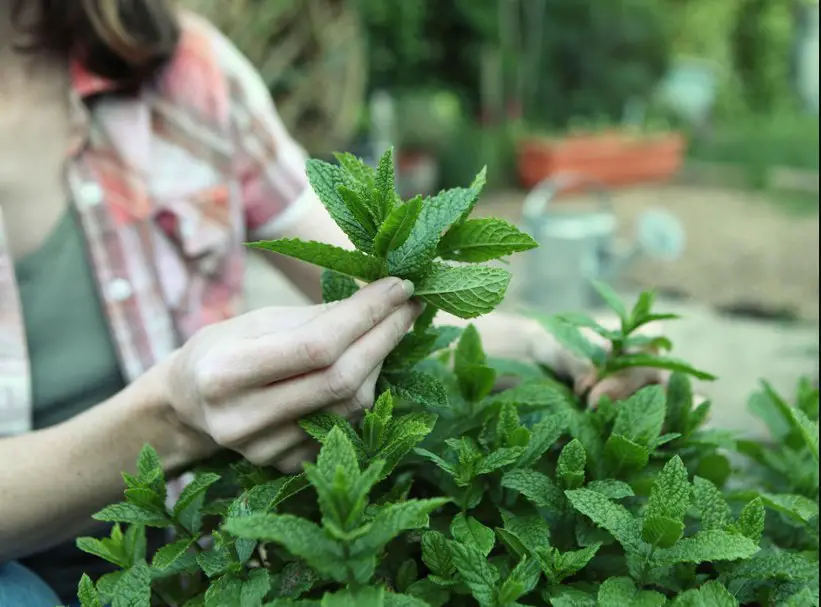
Mint is probably one of the easiest plants to harvest, as long as a few simple guidelines are followed. If these are done correctly, mint can last 5-10 years, depending on whether they are grown indoors or outdoors. Let’s dive into how to harvest mint without killing the plant, shall we?
Table of Contents
What is the best way to cut mint off the plant?
The best way to harvest your mint plant is either by pinching with your fingers or clean cutting with a pair of scissors or pruning shears. The finger method should be used if you only want a few leaves here and there.
On the other hand, if you require greater amounts of your mint plant, use a clean cutting tool so the plant can regrow and won’t go into shock.
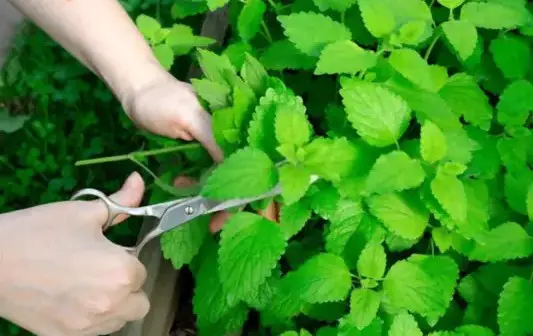
Sometimes a plant needs to time readjust after losing a chunk of itself, and it will want to redirect its energy to focus on growing elsewhere. So using a sterilized pruning tool will allow the plant to sprout straight from the newly cut node instead of fixing any squished limbs beforehand.
Remember, pruning your plant stimulates regrowth, so making sure you cut it back correctly assures that you get the most out of it long-term.
Does mint regrow after cutting?
Like almost all herbs, mint will regrow after cutting. As long as the right method is used, mint can continue to produce an abundance of its leaves for at least 5-10 years. For this awesome herb to reach maturity from seed, it usually takes around 90 days.
They usually grow to around 1-2 feet in height and can be harvested at this point. Once you begin using its leaves, depending on the amount you trim, it will regrow to the same height after a month or so. You can cut them down to around an inch above the soil; like magic, they will shoot up again.
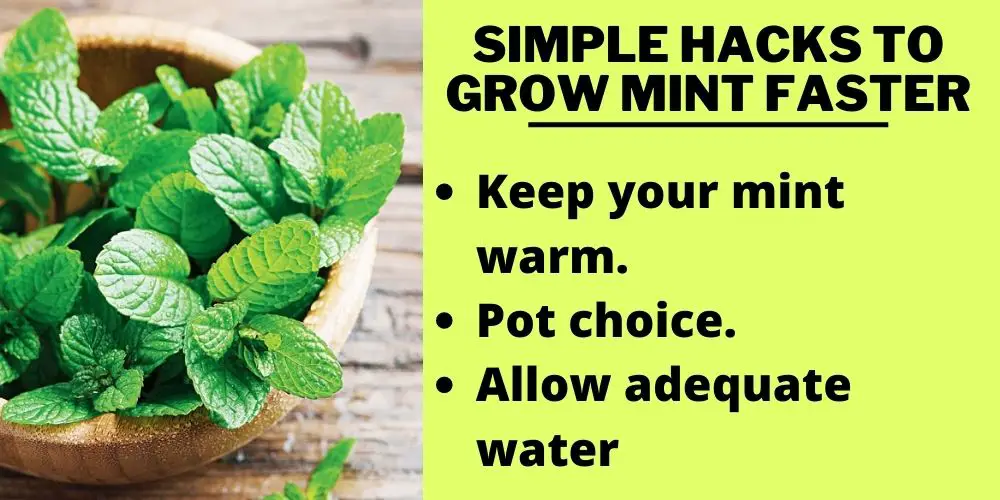
There are a few simple hacks that you can use if you want your mint to grow that little bit faster. They include:
Keep your mint warm
Mint grows faster during the warmer months as they enjoy the temperatures that these months bring. In the colder months, mint can shrivel up and drop all its leaves, making it look dead. Then when spring comes, all of a sudden, you have a mint plant again.
It’s ideal for trimming any dead foliage to around 2-3 inches during winter, so it’s ready to sprout like crazy in the spring again. Keep in mind that too much sun or dry heat will burn the leaves, leaving them shriveled and causing early death for the plant.
Pot choice
Mint loves to spread its root system right out. So much so that it will use the soil’s nitrogen and water up super fast. Nitrogen is important for stem and leaf growth. Ideally, a mint plant should be repotted every 1-2 years so the soil gets routinely changed out. Another consideration is replanting in a larger pot to allow the roots even more space, nitrogen and water to ensure they can bush right out.
Allow adequate water
Mint loves water; they suck most of it up as fast as they can use it. That’s not to say that you should drown your mint plant but make sure you consistently check that there is enough moisture in the pot. Consider giving that little bit extra during the warmer months. Ideally, a mint plant should be watered every 2-3 days for optimal growth.
Depending on a mint plant’s growing conditions, it can grow 2-4 times per year over its lifespan of at least 5-10 years. Like all plants, mint requires water, light, food (nutrients), heat (temperature), and the right soil to produce an optimal harvest. If it lacks any of these components, the unbalanced nature could see that it either grows slower, not as full or even not allow it to survive.
How to Harvest Mint Without Killing The Plant? (My Secret Method)
Mint is a hearty, fast-growing plant; it takes quite a bit of poor treatment to take down a herb of this caliber. In saying that, multiple key factors ultimately decide how to harvest mint without killing the plant.
The most important point to note is that you need to make sure that you trim your mint in such a way as to promote regrowth right from the first snip.
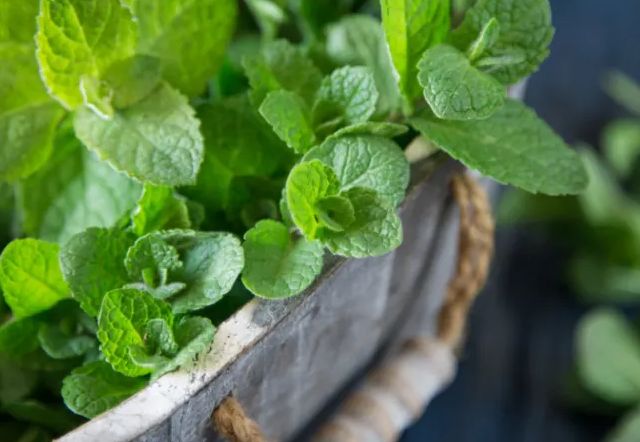
The most common mistakes people make are cutting the plant at the wrong time, trimming them down way too low or using the wrong tools. If you cut your mint plant back in its first year, the harvest is much less than in its second year.
If a mint plant is cut down too low, it can either go into shock and die or take much longer to regrow than it would if cut at the 2-3 inches above the soil mark.
Using the wrong tools can stunt the growth of your mint plant by forcing it to grow from uneven cuts, which can put extra stress on it, which is not ideal. The best practice is to use a sharp, clean pair of scissors or pruning shears.
How do you know when mint is ready to pick?
In general, mint can be harvested any time after it reaches 3-4 inches in height. At this stage, the outwards stems should be around 6-8 inches long. It will be fully mature after 70-90 days from the time it was planted and be around 3 feet tall.
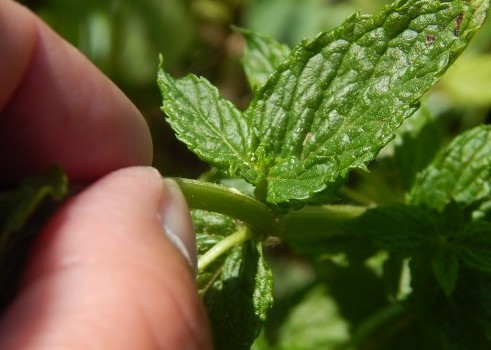
So with that in mind, it can be ripe for picking before maturity. Something else to consider is how much you wish to pick. If you just need a few leaves here and there, then it won’t affect your plant’s continual growth. If a larger amount is needed, it’s better to let it bush right out before considering a greater harvest.
Things Required to Harvest Mint
- A clean, sharp pair of scissors or pruning shears.
- A bucket or tote to collect all of your mint trimmings.
Harvesting Mint without Killing the Plant: Step-by-Step Guide
Harvesting mint is not only simple but also rewarding as you get to smell the strong aroma of this plant when it’s at full force. The best time of day to start picking is in the morning.
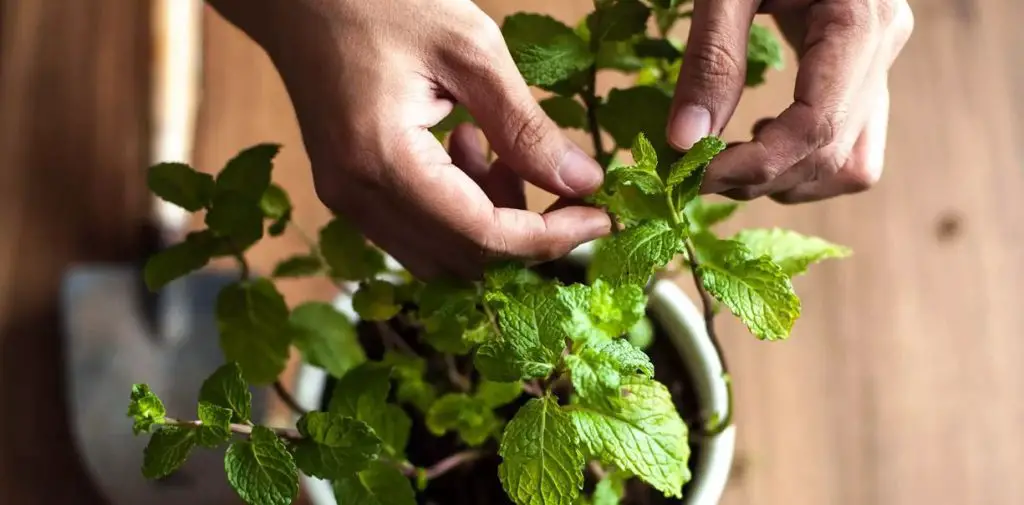
At this time of day, the essential oils are at their peak flavor, and the leaves are lush and fresh. The harvesting process doesn’t require direct instructions, but there are a few things to consider.
- Before using some of your mint plants, deciding just how much you need is a good idea. This factor will help you decide what trimming tactic you should use. Mint is one of the easiest herbs to harvest. It’s as simple as plucking off some leaves at will. That’s if you only want a small amount.
- Alternatively, cut the desired amount of stem down to just above a node (part of the stem where more stems/leaves grow). Cutting above the node encourages faster regrowth which multiplies from the node. In contrast, cutting below the nodes forces the plant to try to regrow said nodes first, which often takes longer and may not be as plentiful.
- If you plan to stock up for the long term, the best way to prune your plant is to cut the desired stems down to a few inches from the soil and allow it to grow back in full before harvesting that same area again.
- A good strategy is to start outside the plant and work your way in. This way, you’re allowing your mint plant time to regrow whilst still being able to enjoy the fruits of your labor. Additionally, if you have multiple plants, try to rotate through them to also give them time to regenerate.
- Remember, the key to harvesting anything long-term is allowing them the best chance to regrow. Clean cuts, time and the standard growth essentials, including water, fertilizer, soil and light, are optimal.
How to Store and Make Mint Last Longer?
Once you have harvested your desired amount of mint, the next step is storing it. There are a few different storage methods, including leaving it in the refrigerator, drying it out and/or freezing it.
Each method has a different lifespan. It will all depend on how you wish to use it. Firstly, let’s look at how to clean it up in preparation for storage.
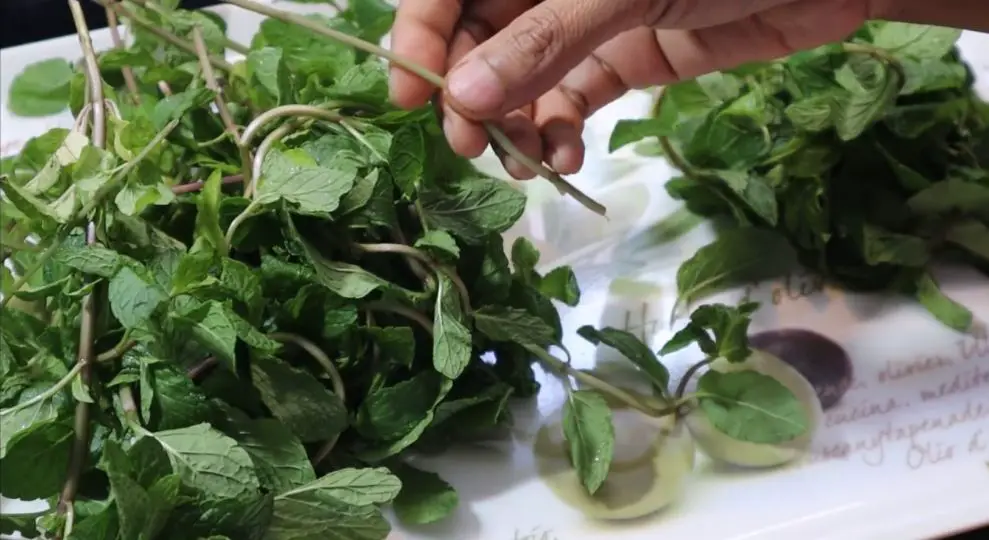
Before washing your mint, it’s a good idea to think about if you are going to want to dry it out later on. We will get to a few different methods shortly, that you can use to dry mint. One of them requires the leaves to stay on the stems so they can be tied together and hung up to dry.
The other method(s) don’t require a stem, so you can remove the leaves before washing. Once that is taken care of, it’s time to clean your mint leaves up!
How to wash mint?
I use mint all the time! When I clean it, I try to avoid anything that isn’t natural. I mix 3 tablespoons of cider vinegar with 6 cups of water in a bowl. I then use the ‘dunk and swish’ method. You simply dip/dunk a whole mint bouquet or just the leaves into the water mix and swish it/them around. Then rinse it off using clean water and drain it in a colander.
How to dry mint?
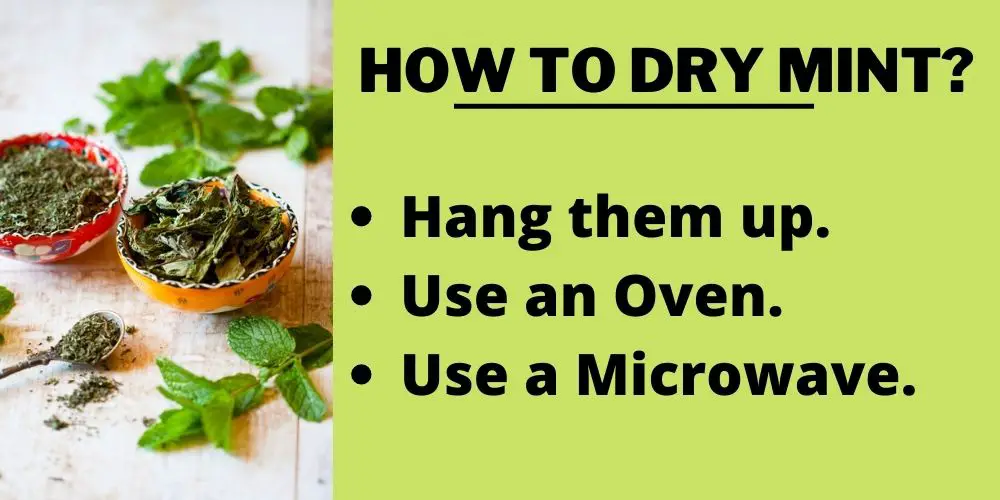
Hang them up
If you chose to hang dry your mint, then the best way to do this is to keep the leaves on the stems. Tie the bottoms of a bunch of stems together using string or thin rope. Hang the stems upside down in a well-ventilated, sunny place like a garage or window.
This method should take 7-10 days. Test your newly dried mint by crumbling some leaves between your fingers. If they crumble easily and seem reasonably dry, they are ready to take down and add to a spice shaker or another airtight container like a mason jar.
Use an Oven
Put some baking paper on an oven tray and carefully arrange the mint leaves on top, allowing space for air to circulate. Don’t add any more than one layer, as they won’t all dry out. Set your oven to a lower temperature as this will prevent the leaves from going brown and burning.
Around 180ºF/80ºC is ideal. This should take between 1-2.5 hours. Check every 15-20 mins to see how they look. When satisfied, remove them and let them cool down before crumbling them. If you try to crumble them when they are still hot, some moisture may remain to make them tougher to break down.
Use a Microwave
You can use a microwave to dry out your leaves, but you may lose some flavor in the process. I prefer the oven method if I can’t hang the stems, but quite often, time is a factor that pushes certain decisions. Lay the leaves out on a big plate, ensuring they aren’t lying on each other.
One layer is preferable. Set the timer for 5 mins at full nuke. Check the leaves out when around 2 mins remain to see how they look. Keep stopping and starting every 30 seconds and checking.
All microwaves are different, and 15-30 seconds too long could burn your mint to a crisp! Once you are satisfied with the results. Go ahead and crumble your leaves for storage.
How to store mint in the refrigerator?
The easiest way to store mint and keep it fresh in the refrigerator is to roll it up and bag it. To do this, simply lay out some paper towel or a kitchen towel. Then spread the mint out in an even layer over the towel. (It’s ok if it is still a bit moist) Roll up the towel with the mint inside.
Put the rolled towel inside a sealable plastic bag and lay it in the fridge. Your mint should stay fresh for 1-2 weeks. On a side note, if the mint wasn’t dripping wet when rolled, the leftover moisture will keep it a little extra fresh.
Another alternative is to place your mint stems with their leaves attached in a small glass or jar filled with water. This should resemble flowers in a vase. Then take a plastic bag and cover the leaves loosely, so they don’t suffocate. Store them like this in your fridge. They should last upto a week without any problems.
How to store mint in the freezer?
If you want to extend the life of your mint leaves, you can store them in your freezer. The taste and aroma may slightly lessen using this method. Using some ice cube trays, add 3-4 leaves per cube section, filling the whole tray if possible.
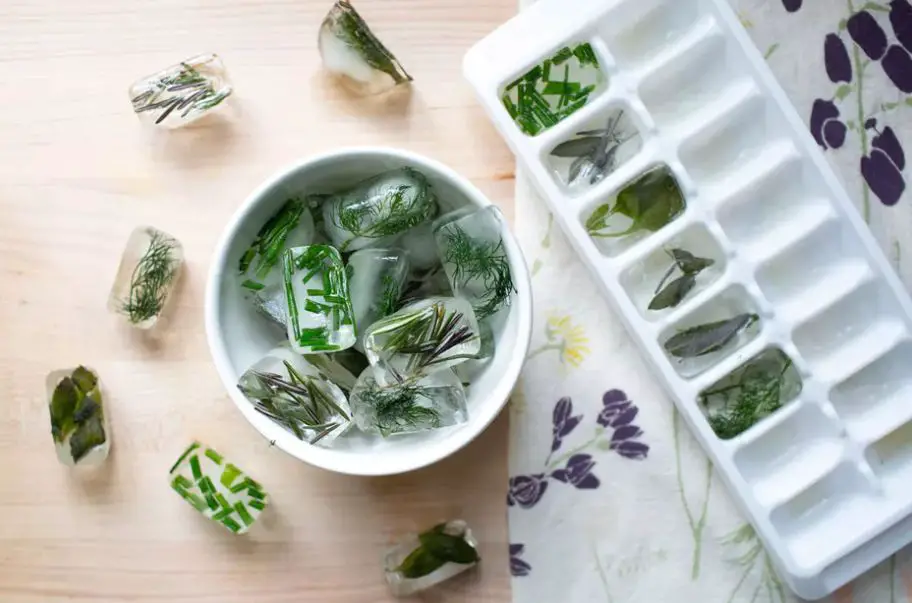
Add water to each cube and leave it in the freezer until frozen. The cubes should last 3 months and are great for summer drinks or even winter teas. Just throw a few cubes in your desired blend, and like magic, they are now infused with mint!
Frequently Asked Questions (FAQs)
How often should I trim mint?
Mint should be trimmed monthly, even if you aren’t planning on using it. The reason being is you want to encourage continual growth. Once you start pruning a mint plant, it will multiply and start bushing much more outwards. Once the stems grow to around 3-4 inches tall, cut the back to help regenerate.
How quickly do mint leaves regrow?
Depending on how many you remove, they grow back extremely fast. If you remove 1 leaf, for example, 2 new ones can appear within the next 3-4 days. Mint can grow fast when planted in the right conditions. That’s the beauty of this herb, and to think they keep growing for upto 5-10 years.
Should I cut mint runners?
This question is debatable. Some growers like the runners to keep sprouting new mint plants all over the place. They can be a pain in the backside, if you’re trying to keep your garden nice and tidy. Cutting the runners away is a good idea if you don’t want your mint plant to spread. You can also use the runners to propagate new mint plants elsewhere.
What month do you prune mint?
When winter sets in, it’s a good idea to prune back your mint plant to a couple of inches above soil level. Remove any brown/dead foliage, including stems and or leaves also. This way, they will be ready to rock and roll once spring comes around again.
How can you tell if mint is edible?
The only way to know if mint is edible is to taste it! As long as you know that it is, in fact, a mint plant, you can go ahead and take a few leaves and see how they taste. Different mint species have different tastes but all have the same menthol aftertaste.
Conclusion
Well, there you have it, folks; mint is just one of those hard not to like herbs. It smells great, it tastes amazing, and it also can assist in healing certain health ailments. If your mint plant has enough light, water, quality soil, nutrients and heat, it can produce an abundance of wonderful and useful leaves.
We have just learnt how to harvest mint without killing the plant and it isn’t too difficult. All that must be considered is allowing the plant time to regenerate after harvesting. We hope you have enjoyed this information, and we look forward to producing more quality articles like this. Happy growing!


